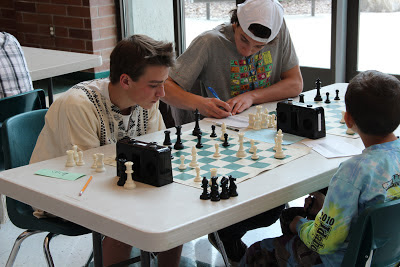Sarcasm: Only the wealthy and intelligent can play chess . . .*sigh* . . .only in Sun Valley!
(Note: the pieces couldn't get any more cheaper looking)
 |
| The Colle-Zuckertort Opening strives to create a strong defense before attacking. The attack options include getting the f-knight to e5 or advancing a pawn down the c-file. |
 |
| Can you find a royal fork? |
 | |
|
 |
| 2012 Fall "Turkey Shoot" Tournament |
 |
| A great day for a tournament with a view down Croy Canyon. |
 |
| Jacob plays Anna in the first round. |
 |
| Des gets ahead in points and pawns, but neglects the back rank and Jacob pulls out a surprise attack! |
 |
| "I took the pawn and blundered the game away!" says Des. |
 |
| Riley has a fierce opening game as she begins the middle game a piece up. |
 |
| Most Inspirational Elementary Player, Collin |
 |
| Rileys only loss was against Desmond. |
 |
| Dylan and Anna play while Matt, Wyatt, and Terry watch |
 |
| Ipads and Tablets entertain players in between rounds. |
 |
| Brother and sister face off. |
 |
| 2012 Barnes & Noble Round Robin |
 |
| Taylor Walton |
 |
| Wyatt and Megan play in their first tournament |
 |
| Don't make a bad move against Fred, he'll make you pay dearly! |
 |
| Fred offers an entertaining game and commentary to Wesley |
 |
| Most Improved Player Award (from Barry) |
 |
| Fred plays Des while Victor observes |
 |
| Dylan plays Brandon |
 |
| Barry plays Anna |
 |
| Andre |
 |
| A great field trip |
 |
| Adam vs. Des, round 7 |
 |
| WinTD wouldn't pair after Round 12, but everyone is tired anyway and the store is closing soon. |
Place
|
Name/Team
|
Rate
|
Score
|
SBx2
|
Solk
|
CumOp
|
Cum
|
1
|
Bartell, Fred (16)
|
nnnn
|
11.0
|
115.0
|
65.0
|
435.0
|
74.0
|
2
|
Porth, Adam (11)
|
nnnn
|
11.0
|
108.0
|
63.0
|
403.0
|
73.0
|
3
|
Eacker, Barry (7)
|
nnnn
|
11.0
|
91.0
|
56.5
|
385.0
|
67.0
|
4
|
Dugger, Gary (1)
|
nnnn
|
9.5
|
94.0
|
70.5
|
502.0
|
64.0
|
5
|
Porth, Desmond (3)
|
nnnn
|
8.5
|
87.0
|
75.0
|
517.0
|
54.0
|
6
|
Avila, Tyler (14)
|
nnnn
|
8.0
|
68.0
|
63.0
|
402.0
|
47.0
|
7
|
Moffett, Kalen (10)
|
nnnn
|
8.0
|
56.0
|
57.5
|
368.0
|
60.0
|
8
|
Arp, Jarod (19)
|
nnnn
|
7.0
|
70.0
|
69.5
|
490.0
|
46.0
|
9
|
Brimstein, Wesley (17)
|
nnnn
|
6.0
|
44.0
|
76.0
|
517.0
|
35.0
|
10
|
Clark, Riley (12)
|
nnnn
|
6.0
|
40.0
|
71.5
|
459.0
|
48.0
|
11
|
Saldivia, Victor (13)
|
nnnn
|
5.0
|
44.0
|
73.5
|
469.0
|
40.0
|
12
|
Caccia, Wyatt (4)
|
nnnn
|
5.0
|
27.0
|
71.0
|
489.0
|
30.0
|
13
|
Murphy, Anna (6)
|
nnnn
|
5.0
|
20.0
|
66.0
|
456.0
|
21.0
|
14
|
Yagla, Brandon (18)
|
nnnn
|
4.0
|
30.0
|
77.0
|
531.0
|
27.0
|
15
|
Hartegon, Nash (2)
|
nnnn
|
4.0
|
29.0
|
74.0
|
523.0
|
22.0
|
16
|
Porth, Dylan (15)
|
nnnn
|
4.0
|
27.0
|
67.5
|
446.0
|
22.0
|
17
|
Jones, Megan (9)
|
nnnn
|
3.0
|
3.0
|
63.5
|
410.0
|
18.0
|
18
|
Murphy, Andre (5)
|
nnnn
|
2.0
|
4.0
|
64.0
|
438.0
|
7.0
|
19
|
Vajello,Victor (8)
|
nnnn
|
2.0
|
3.0
|
70.0
|
464.0
|
12.0
|